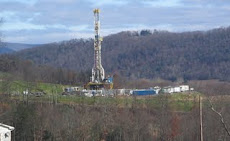Whoever coined the phrase about having to sacrifice for your lunch could have been talking about energy. You name the source of energy and look into it and you'll find there are pros and cons about every one of them. We have been deluged with negative information about big bad oil companies and dirty, filthy coal. Now we're hearing about all this natural gas we can produce from shale rock in many places around the country (USA) and the world. What is the real story?The following article is a good introduction to shale gas and how it has the potential, or even probability of changing America's energy picture. Why isn't the mainstream media paying more attention? Why are we bombarded with pictures and stories of how windmills and solar panels are the answer to our energy needs? I think the answer is in the forces that have been behind the great scandal going on over the myth of man-caused global warming. For more information on that subject, go here.PeterAn energy answer in the shale below?
New technology opens vast stores of natural gas, and the land rush is on
By Steven Mufson
Washington Post Staff Writer
Thursday, December 3, 2009 (source)
The first time Chesapeake Energy tried to buy mineral rights from Diana Whitmore, a 74-year-old retired real estate broker in southern New York, it offered her $125 for every acre of land plus a 12 percent royalty on whatever natural gas it extracts.
Nearly two years later, she's still holding out. Along with hundreds of other landowners, she has joined a coalition that is negotiating with nine oil and gas companies. The latest offers in the area are running as high as $5,500 an acre with 20 percent royalties.
"It's what's really going to turn this whole place around," said her son Daniel Fitzsimmons, who has since helped form the Binghamton Conklin Gas Lease Coalition.
This corner of the state is at the forefront of an old-fashioned land rush that has implications far beyond Conklin, N.Y. Oil and gas companies are vying to stake out territory where they can tap natural gas trapped in shale rock. Just a few years ago, the industry didn't have the technology to unlock these reserves. But thanks to advances in horizontal drilling and methods of fracturing rock with high-pressure blasts of water, sand and chemicals, vast gas reserves in the United States are suddenly within reach.
As a result, said BP chief executive Tony Hayward, "the picture has changed dramatically."
"The United States is sitting on over 100 years of gas supply at the current rates of consumption," he said. Because natural gas emits half the greenhouse gases of coal, he added, that "provides the United States with a unique opportunity to address concerns about energy security and climate change."
Recoverable U.S. gas reserves could now be bigger than the immense gas reserves of Russia, some experts say. The Marcellus shale formation, stretching across swaths of Pennsylvania, New York and West Virginia, has enough gas to meet the entire nation's needs for at least 14 years, according to an estimate by two Pennsylvania State University experts. Just in Broome County, N.Y., where Fitzsimmons lives, shale gas development could create $15 billion in economic activity, according to consultants hired by the county.
The country is carpeted with shale gas plays, including the Barnett in Texas, Fayetteville in Arkansas and Haynesville in Louisiana. Since 2000, gas from shale has grown from less than 1 percent of the nation's production to about 10 percent, according to the consulting firm PFC Energy, and it's picking up fast.
That's changing the energy and economic landscape from Broome County to the Gulf of Mexico. It could mean lower prices and reassurance to homeowners who heat with gas, or towns and companies with vehicle fleets running on the fuel. As winter begins, the price of natural gas is about a third of the level it was 14 months ago. Storage facilities are bursting.
With new supplies, the country will be less vulnerable to disruptions from Gulf Coast hurricanes and need to rely less on imports. Already, deliveries of liquefied natural gas from places such as Qatar, Nigeria and Trinidad are down 58 percent in 2008, idling costly U.S. terminals.
The prospect of new gas supplies at stable prices is also transforming debates over climate change. It deals another blow to proposals for new coal plants. And because gas plants can be switched on and off quickly, unlike coal and nuclear, natural gas could supplement wind and solar power facilities, whose output varies with the weather.
"Natural gas can serve as a bridge fuel to a low-carbon, sustainable energy future," said former Colorado senator Timothy Wirth, now head of the U.N. Foundation. Indeed, this year, coal use is down about 13 percent, while electricity demand has fallen only 5 percent and natural gas use has remained about steady.
But the prospect of widespread shale gas drilling is also driving wedges in the environmental community. Many environmentalists have sounded alarms about the chemicals that drillers use to fracture the rock and the danger of natural gas or other substances contaminating water supplies. A video posted on the Web shows a man in Fort Lupton, Colo., lighting a fire with the tapwater in his kitchen sink -- although it isn't clear what caused that problem.
Residents of New York City, which draws drinking supplies from a large watershed that reaches up to the Catskill Mountains, have protested, and Chesapeake Energy has voluntarily announced that it would not drill in the watershed. Gov. David A. Paterson (D) has declared a moratorium on drilling until the state's Department of Environmental Conservation issues rules, which are open for public comment. A raucous meeting in Manhattan last month ended before even a third of the people who wanted to comment got a chance to speak.
"This is probably the biggest thing to happen to the state of New York since the initial clearing by settlers," said Wes Gillingham, executive director of the Catskill Mountainkeeper.
In north Texas, some people are also wondering whether drilling in the Barnett shale is to blame for a series of barely perceptible but highly unusual earthquakes now being investigated by geologists.
Yet other environmental groups favor developing gas to displace coal. "There are legitimate concerns that need to be addressed," said Bruce Nilles, a lawyer at the Sierra Club. But, he added, new natural gas supplies could be a "game-changer" in the battle against coal plants.
Nilles said New York's 20 coal plants largely burn Appalachian coal from areas with mountaintop removal. "The status quo means continuing to destroy the oldest mountain range in the country," he said.
Credit for discovering that gas could be economically extracted from shale generally goes to George Mitchell, former head of Mitchell Energy. In the early 1980s, as the company's production was declining, Mitchell and his geologists started experimenting with "hydraulic fracturing" -- blasting underground layers of shale with a mixture of water, chemicals and sand to crack the rock and get gas flowing out of it.
"Mitchell had hired an investment banking firm in 1999 to see if anyone wanted to buy them," recalled Larry Nichols, chief executive of Devon Energy. "Devon and everyone else looked and said, 'No, that technology doesn't work.' We, like everyone else, turned up our noses."
Three years later, Devon paid $3.1 billion to acquire Mitchell. It combined hydraulic fracturing with horizontal drilling, which enabled a single well to turn, follow a seam of shale for up to two miles and produce much more gas. Now a quarter of the natural gas produced by Devon, a $30 billion company, comes from shale.
Historically, most of the natural gas produced in the United States came from relatively small pockets in porous rock. The oil and gas industry has been "eternally searching for relatively small traps," Nichols said. Shale, by contrast, is widespread and hard to miss. "Devon has drilled 4,000 wells in the Barnett and is planning 4,000 more, at least. And we have not drilled a dry hole," Nichols said.
The stakes are high for companies and consumers, as well as the environment. Shale gas has already added billions of dollars to the value of companies like Devon, but it unsettles people living in scenic portions of Pennsylvania and New York, which were the first places oil was discovered but which have been relatively undisturbed for decades.
Some people are just happy about the money. Fitzsimmons, for example, suffers from arthritis and has a nonverbal autistic 18-year-old son. He and his family own 185 acres. "If you're a property owner, it's amazing," he said. "Even some of the ones who are members of these organizations that are supposedly against it -- when it comes time to get a check on their property, suddenly they're all for getting the check."














